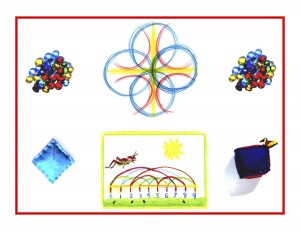Day 130
For one year, 365 days, this blog will address the Common Core Standards from the perspective of creating an alternate, ambient learning environment for math. Ambient is defined as “existing or present on all sides, an all-encompassing atmosphere.” And ambient music is defined as: “Quiet and relaxing with melodies that repeat many times.
Why ambient? A math teaching style that’s whole and all encompassing, with themes that repeat many times through the years, is most likely to be effective and successful. Today’s post will feature the next Grade 2 Common Core Math Standard listed in blue, followed by its ambient counterpart as practiced by Waldorf Education and Math By Hand.
Number and Operations in Base Ten 2.NBT
Understand place value.
1. Understand that the three digits of a three-digit number represent amounts of hundreds, tens, and ones; e.g., 706 equals seven hundreds, zero tens, and six ones. Understand the following as special cases:
a) 100 can be thought of as a bundle of the tens — called a “hundred.”
b) The numbers 100, 200, 300, 400, 500, 600, 700, 800, 900 refer to one, two, three, four, five, six, seven, eight, or nine hundreds (and 0 tens and 0 ones).
Place value is taught at the start of the second math block so practice with the 4 processes can move on to the next level. This absolutely must be taught concretely, with lots of images and movement. Here’s a place value story. When I taught charter school homeschoolers, I visited students one-on-one every other week in their homes. One of my students, a second grade boy who could not get the concept of place value and regrouping, was also an electronic wizard. Ironically, he was able to engineer advanced electrical projects, like setting an alarm device under the front door welcome mat that would sound in his room whenever someone visited. Amazing! Yet, he was stumped by this math concept.
I lay four big felt columns on the floor: red, yellow, blue, and green, and told him that the red was the 1’s column, yellow the 10’x, green the 100’s, and blue the 1,000’s. After writing five sets of the numbers 0-9 on blank index cards, and very small cards numbered 1’s and 2’s, I set up a column of three three-digit numbers on a large piece of paper:
352
768
+234
I then instructed him to place the numbers on the correct columns and to begin adding up the 1’s column. (Any aids can be used for adding here: counting on fingers, stepping, jumping, etc.) When he reached the 1’s total, I asked him how he would show the answer. He put the 4 at the bottom and I handed him a small “1” card, telling him to jump to the top of the 10’s column with it. He jumped, and he got it, instantly!
Math By Hand uses this model, along with a smaller, tabletop version. In this version there are three columns, red, yellow, and blue, that are used with three kinds of beans in color coordinated pouches: black beans/red/1’s, kidney beans/yellow/10’s, lima beans/blue/100’s. The beans are used as counters and “cashed in” for the next higher beans when needed. Both of these activities make the concepts fully concrete and pictorial.
These concrete models work a lot better than either the circles and tally marks on paper or the unifix cubes that are used on Common Core worksheets. Confusion clears up instantly and magically when concepts are tied to stories, images, or objects! Remember that knowledge ensues in an environment dedicated to imaginative, creative knowing, where student and teacher alike surrender to the ensuing of knowledge as a worthy goal. Tune in tomorrow for more Common Core, along with its ambient, Waldorf/Math By Hand counterpart.












